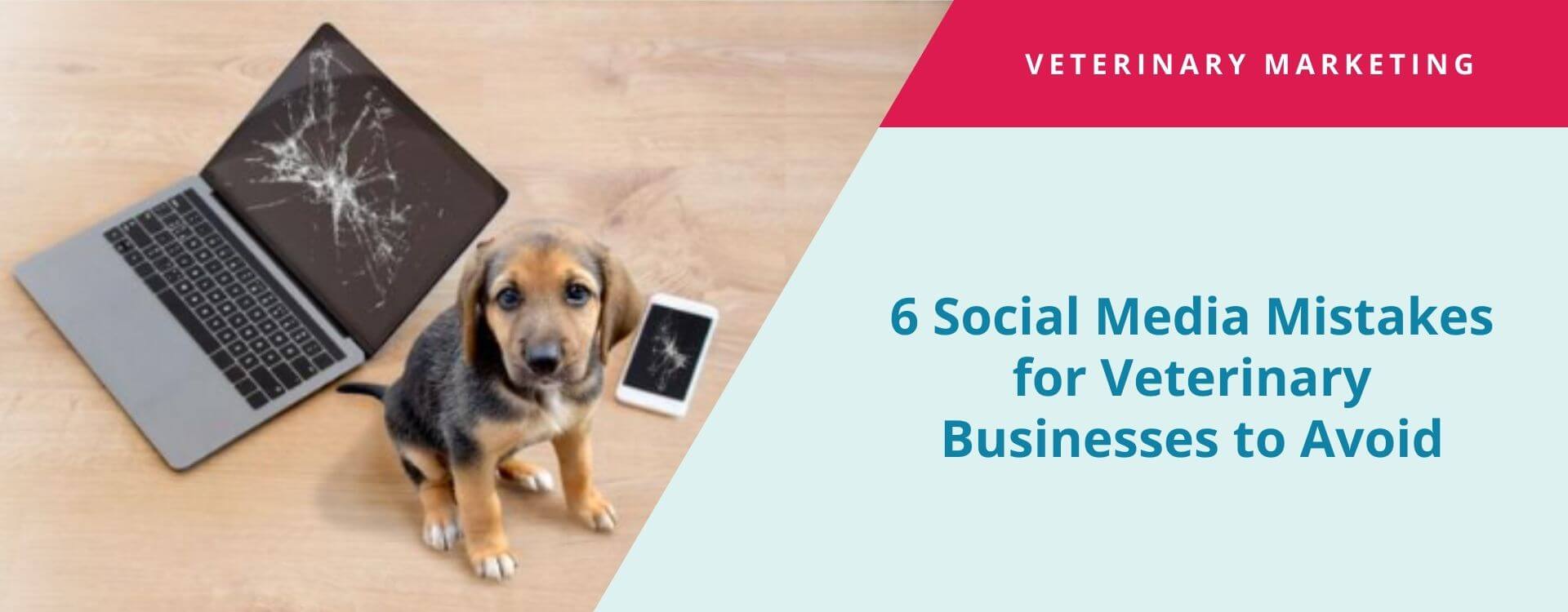Oops! 6 Social Media Mistakes for Veterinary Businesses to Avoid
If you have a personal social media account or two, chances are you’ve posted something that you consider a mistake. Maybe you posted a statement with a typo, or perhaps you “fat-thumb” liked something that you wholeheartedly disagree with. As a result, you had someone poke a bit of fun at you, or you might have attracted full-on trolling. When this happens on your personal accounts, you get to explain yourself, and your true friends are likely to forget quickly.
However, for your veterinary practice, whether someone pokes fun at your mistake or ends up with a tsunami of angry commenters, it’s time to take damage control seriously. It’s often been said that the best defense is a great offense, and learning how to avoid the following list of common social media mistakes can ensure you spend less time backtracking and more time enjoying social high-fives.
- Not Establishing a Goal - Your social marketing goals can be as broad as building your brand’s presence in local pet care conversations or as specific as filling your boarding reservations over summer break. The timeline is up to you, too. Would you like to accomplish your goal over a month, a quarter, or six months?
But no matter what, you need to have an aim in sight. Otherwise, local pet owners won’t have a coherent message from you; they won’t have something consistent to remember or associate with your business. Plus, you won’t have an accurate benchmark for measuring social marketing success.

According to Forbes:
Not having a social media strategy is a mistake. A strategy is purposeful and intentional to allow you to set goals and objectives with which you can measure impact. How you monitor and evaluate your social media channels, content distribution and engagement should be identified in advance. You can address how the company will respond to comments, questions and backlash to prevent further faux pas.
- Creating a One-Sided Broadcast - In social media marketing, the operative word is “social.” Facebook, Twitter, and Instagram are not the same as newspaper ads or roadside billboards. On the one hand, you want to cast the net wide enough that your social posts have billboard-like reach. But on the other hand, you want to know what people are saying about what you’ve posted -- and maybe more importantly, you want to respond.
On social media, you don’t just post veterinary information. You join pet care conversations.
- Not Being Responsive To Your Audience - Sprout Social notes: Social offers huge potential for customer engagement, a primary goal for many marketers, and a positive influence on customers’ decisions to buy from a brand. Responsive brands that continuously react and engage in two-way communication with consumers are better equipped to serve their customers’ needs, dial up personalization and humanize their content in a way that forges deeper connections with customers. Conversely, ignoring customers or having slow response times will almost surely lose you business.

Buffer highlights the benefits of acknowledging and responding to your social followers. Check out what happens when a brand takes the time to answer customer questions on social platforms:
- 70% of people are more likely to use the brand’s product or service.
- 65% of people have more brand loyalty.
- 75% of people are likely to share a good experience on their own profile - Creating Only One Type of Post - It’s tempting to post only links to your website. After all, it’s your practice’s social media, so why not use it to drive as much web traffic as possible? Then more people will know all about your services and hopefully book appointments!
In truth, links are great, particularly when you mix links to your clinic website with links to other authoritative sources, such as AAHA or AAFP. But in the same way that the most successful TV networks plan their programming, you should strive for variety: news, information, DIY, charm, comedy, and more. Your posts should include those links along with photos, video and live events, graphics, shared posts, and even polls and contests. For example, even though Instagram is a photo-sharing platform at its base, it supports short videos, too.
It’s easy to tune out a message on social media if that message looks the same day after day. So look beyond links and walls of texts. Your clients would love to see snapshots of their beloved pets in your office or behind-the-scenes video of pet care tips from your staff. In fact, through analysis of more than 6 million Facebook posts, Buffer “found that videos uploaded onto Facebook receive more engagement and shares than [links to] YouTube videos on Facebook.”
Your clients are as diverse as the array of their pets -- your patients -- and you should post with that in mind.
- Skipping the Proofreading Steps - Maintain the professionalism of a veterinary practice, even on platforms like Twitter and Facebook. Produce error-free posts to protect your credibility and put your best social face forward. Plainly put, “Grammatical errors just are not a good look.” Entrepeneur.com notes that these mistakes are “a much larger problem than most people probably think.” Thankfully, “The solution is straightforward -- use spell check, and make sure you don’t make these common grammatical errors.”

While you’re at it, reread your posts for voice and tone. Is your social voice too casual: full of slang, juvenile abbreviations, or an overload of hashtags? Or, do you appear aloof and out-of-touch due to too much jargon? Just as grammar mistakes can make you less trustworthy in the eyes of your social followers, so can striking a tone that doesn’t match your profession or practice culture. Think of the telephone skills you ask of your receptionists or the exam room skills you want from your techs. Then, take your own advice during social marketing.
- Wading into Controversies or Politics - Your opinions absolutely matter, but when you’re on social media representing your veterinary practice, your focus should be on issues that pertain to pets. Clients and potential clients visit your pages or feeds for pet care guidance, important announcements, and cute cat videos (see point number 6 below). Follow this advice from Entrepreneur:
Remember that you aren’t the only person who will be reading what you post, which is why you should never discuss things like religion or politics on social media. Other people reading your content will have a wide range of beliefs and opinions. Being conscious of this will help you avoid pushing potential customers away or receiving public backlash.
You have to be respectful of others’ feelings. A single tweet or Facebook post that is controversial can bring with it a complete PR disaster.
Your social followers didn’t intend to see who you voted for in the last election or what you think of the latest Hollywood scandal. But if they find that info on your business’s account, a few disasters are quite possible:
- Those who agree with you could essentially cheer you on, spreading a message that has nothing to do with your services or culture
- Those who disagree with you could feel alienated and decide to seek veterinary care elsewhere
- Those on any and all sides of the issue could argue in the comments section, undermining the pleasant and helpful tone that you should strike on all your social platforms
In all of these cases, trust is broken, and you risk losing your standing as a local pet care authority.
- Being All Business - Social marketing should ultimately positively impact your bottom line. You want to educate your clients to increase client compliance and drive contacts for appointments. But overselling can be a problem. Of course, the goal of social media is to convert your audience, but making that attempt painfully obvious will send the reader running in the other direction. Don't be a small business that forgets this concept and goes for the hard sell—instead, use quality content through blog posts, videos, and more to drive people to your site.
Furthermore, from Forbes:
Fans and followers will see through hard sells in posts if that is all they are seeing. Instead, think of promoting your business as a "commercial break" among other content that provides value.

Add social value to your posting with the mix from point 3 above. Your social followers will feel rewarded and appreciated, and you’ll feel more motivated to keep it up when you realize that posting puppy photos is actually part of your job!
We want you to take social media risks, like trying out Facebook Live for the first time or using Instagram to run a business contest. These are great learning experiences, and they can pay off big time in terms of client bonding and new client acquisition. But take care to avoid missteps when you can so that social marketing can perform at its best for your veterinary practice.
Ready to learn even more about what works in veterinary marketing -- and be able to use this knowledge right away? Get your copy of our GeniusGuide, The Top 5 Facebook Post Types That Work For Veterinarians! Also, schedule a GeniusVets Demo to learn more about making expert hires and improving your profitability.

